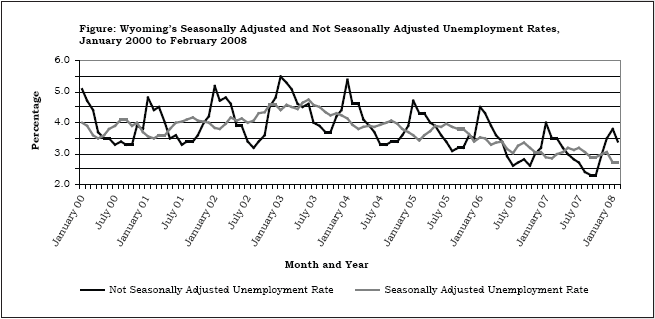Ask an Economist
QFrom December 2007 to January 2008, the state’s unemployment rate fell, and yet at the same time we lost 6,500 jobs. Don’t these two statements contradict each other?
ASeveral factors explain why the unemployment rate could fall even while the number of jobs declines. First, we need to understand what these numbers represent. The unemployment rate comes from Research & Planning’s (R&P) Local Area Unemployment Statistics (LAUS) program, which is funded by the Bureau of Labor Statistics (BLS). LAUS is used to estimate persons in the labor force by place of residence and is seasonally adjusted (Azar, 2008). Seasonal adjustment removes from data the effects of recurring events that follow a more-or-less regular pattern. This makes it easier to observe the cyclical and other nonseasonal movements in a data series.
The number of jobs in the state is estimated by R&P’s Current Employment Statistics (CES) program, also funded by BLS. CES is used to survey employers on a monthly basis and estimates the number of jobs by place of work. This number is not seasonally adjusted and may include multiple jobs worked by the same individual.
Now we can take a closer look at the numbers. There are three main explanations for an apparent inconsistency between the unemployment rate and the number of jobs:
Seasonality: The nonseasonally adjusted unemployment rate for January 2008 (3.8%) was higher than the nonseasonally adjusted unemployment rate for December 2007 (3.5%), even though the seasonally adjusted unemployment rate decreased from December 2007 to January 2008 (see the Figure). Because CES estimates are not seasonally adjusted, the nonadjusted unemployment rate may be a more reasonable comparator.
Multiple jobholding: CES estimates reflect a count of jobs, not workers; therefore, some of the job loss in January may have been the result of a decline in multiple jobholding. Research has shown that as wages rise, the number of multiple jobholders declines (Knapp, 2007). As long as a person still holds at least one job, he or she is not counted as unemployed.
Labor force decline: The number of people in Wyoming’s labor force decreased by 1,244 individuals between December 2007 and January 2008. BLS uses a fairly strict definition of unemployed. If the number of unemployed declines – because, for instance, individuals give up on finding a job, enroll in school full-time, or move to another state – both the number of unemployed and the labor force estimate are affected. Additionally, new entrants or re-entrants to the labor force affect both the unemployment rate and the labor force estimate.
Azar, R. (2008). A closer look at LAUS. Wyoming Labor Force Trends, 45(2). Retrieved April 4, 2008, from http://doe.state.wy.us/LMI/0208/a2.htm
Knapp, L. (2007). The effect of average weekly wages on multiple jobholding in Wyoming: A comparison of industries. Wyoming Labor Force Trends, 44(2). Retrieved April 4, 2008, from http://doe.state.wy.us/LMI/0207/a1.htm
To submit a question to “Ask an Economist,” please e-mail April Szuch, aszuch@state.wy.us, or Phil Ellsworth, pellsw@state.wy.us.
Return to text

Last modified on
by April Szuch.
